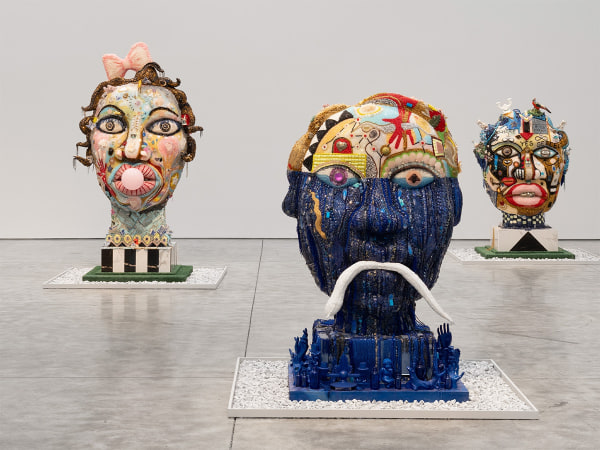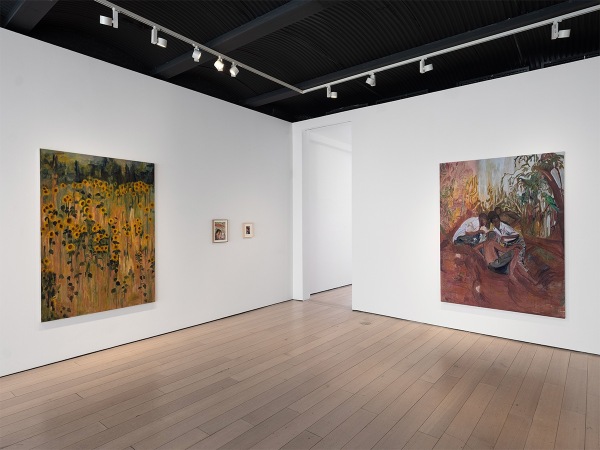Alain Jacquet & James Rosenquist: Perrotin New York
-
-
Perrotin New York
130 Orchard St
New York, NY 10002Kasmin is pleased to present Alain Jacquet & James Rosenquist, in collaboration with Perrotin New York and thanks to Sophie Matisse and Gaïa Jacquet-Matisse, Mimi Thompson and Lily Rosenquist. This sweeping exhibition elucidates the expressive work of Jacquet and Rosenquist. Most notably associated with the Pop Art movement, these two artists were contemporaries and friends who shared similar interests and practices. The gallery's first floor highlights the artists' interest in space, while the second floor features artwork from the 1960s.
Alain Jacquet and James Rosenquist: two artists forever labeled as Pop artists but whose work (like that of most good artists) transcends labels. Born in the 1930s and coming onto the art scene in the 1960s, they could not help but be marked by social transformations of the postwar era, what the French later came to call les trente glorieuses: a period of economic expansion and prosperity but also of profound anxiety, the causes of which included the cold war and attendant fears of nuclear disaster. It was also the time when humans first ventured into space— science fiction fables seemed to be coming true—and this was another effort fueled by military competition between the Soviet Union and the United States; again, mixing optimism and unease. No wonder that evocations of outer space recur in both artists’ work, but curiously enough, starting only after the space program was receding from the headlines—in the 1970s in Jacquet’s case, and in Rosenquist’s, around 1980. Of course, theirs is in every sense a space of the imagination. The famous anecdote about Rosenquist’s massive painting Star Thief (1980) speaks volumes: The work, which depicts such things as machine parts, a woman’s face, and some strips of bacon amidst a star-spangled cosmos, was supposed to be installed in the Miami Dade County International Airport, but was rejected after Frank Borman, the former astronaut who had become chairman of Eastern Airlines, objected: “Space doesn’t look like that. I’ve been in space and I can assure you there’s no bacon in space.” Someone should have reminded him that the earth, after all, floats in space, so all the bacon on earth is in space too, the ultimate surround of all that exists. But if there are more things in heaven and earth than the astronaut dreams of, the artist senses and responds to their impingement. Everything that affects us exists simultaneously in the limitless universe and in the equally limitless human mind.
The careers of Jacquet and Rosenquist ran parallel from the 1960s: they first met in Paris in 1964, the same year Jacquet moved to New York, and in the 1980s they became neighbors and close friends. Both artists were masters of collage, taking fragments of the everyday image environment as material to be taken apart and recombined in constructing their responses to contemporary life. But while they shared certain themes and interests, their aesthetic leanings were more divergent than might be obvious at first glance.
Perhaps the most crucial difference might be in their attitudes toward the use of new technologies in art. Rosenquist, though he drew constantly on the technical image world as a source for motifs, expressed indifference to the internet and eschewed mechanical means of production, maintaining his faith in the human hand and its wondrous abilities as shown by the old masters in works, as he said, “made with minerals mixed in oil schmeared on cloth with hair from the back of a pig’s ear.” His early experience as a painter of billboards had taught him how traditional tools used in a new context and at a different scale afforded entirely new effects. For him, the ancient tools retained infinite possibilities. Jacquet, by contrast, was endlessly fascinated by the new artistic possibilities offered by developing technologies, and especially, I think, by the way these techniques encourage us to rethink the meaning of authorship— which is to say, of human agency. Jacquet had long been intrigued by the possibility of painting by systematic and mechanical means. In the 1960s, like Robert Rauschenberg and Andy Warhol, he availed himself of silk-screening—he called it Mec Art. (“Mec” of course is short for “mechanical” here, but I can’t help remembering that it is also French slang for “guy”—so it’s both mechanical and human.) As we see in such works as the famous silkscreen on canvas Le Déjeuner sur l'herbe (1964) or to a degree approaching abstraction in Portrait d’Homme (mauve, vert, noir), also from 1964, the image was fragmented and transformed—but also transformed was the task of the artist: In the new world of endlessly produced and reproduced media imagery, he became an editor and manipulator of forms rather than an executant.
Among the images to which Jacquet was drawn was the first photograph of the Earth taken from the moon in 1969, which he used as a source repeatedly in the 1970s and 1980s. Just as he had decomposed images into dots that could expand in scale, he realized that the earth seen from space was itself nothing more than another dot made of smaller dots, which can in turn form images within the image. Then, as an early adopter of the computer, he began using it to transform images of the Earth and other planets into comical sausage and donut forms, even using these to create cosmic pastiches of famous artworks from the past, as in Bonjour Monsieur Courbet (Version rouge négatif) (1999). Poor Mr. Borman! If only he’d known that after Rosenquist discovered bacon in space, Jacquet would launch some sausages up there. And in Mars et Venus (2eme version) (1995), Jacquet stages an absurd copulation of forms among the galaxies; he seems to suggest that, even in exploring the vast realm beyond our sky, we never leave behind our quotidian concern with food and sex. Rosenquist, by contrast, remains more of a romantic. In 1965, he became interested in Eastern religions while at the Aspen Institute. In works such as Super Mega Universes (2012), or Fractals Caught Approaching Zero (2013), the sublimity of the starry sky becomes refracted and multiplied as in a kaleidoscope—the childish toy serving only to increase the sense of wonder. Rosenquist once remarked that “their parallel existences on earth and in space” might threaten to make astronauts go mad, but like Jacquet, he knew we all share that parallel existence, and looked to art for sanity.
— Barry Schwabsky
-
About the Artist
 James Rosenquist installing Horse Blinders (1968–69), Wallraf-Richartz-Museum, Cologne, 1972. Photo by Wolf P. Prange. Artwork
James Rosenquist installing Horse Blinders (1968–69), Wallraf-Richartz-Museum, Cologne, 1972. Photo by Wolf P. Prange. Artwork -
Join our Newsletter
* denotes required fields
We will process the personal data you have supplied in accordance with our privacy policy (available on request). You can unsubscribe or change your preferences at any time by clicking the link in our emails.
-
Explore
-

vanessa german: GUMBALL—there is absolutely no space between body and soul
April 3 – May 10, 2025 509 West 27th Street, New York, 514 West 28th Street, New YorkKasmin presents its second solo exhibition of new work by artist vanessa german, which debuts related bodies of sculpture across two of the gallery’s spaces in New York. The exhibition deepens german’s singular approach to sculpture as a spiritual practice with the power to transform lived experience. Both series comprise mineral crystals, beads, porcelain, wood, paint and the energy that these objects bring to life to form monumental heads and figures in the act of falling. Together, each body of work envisions the transformation of consciousness necessary to imagine a new world. -

Helena Foster: Time Honoured
April 3 – May 3, 2025 297 Tenth Avenue, New YorkThe first New York solo exhibition of London-based painter Helena Foster features new oil paintings on linen, paper, and vellum that express the artist’s lyrical approach to painting as an accumulation of cultural and generational wisdom. Foster draws freely from literature, theater, film, Igbo oral tradition, and religion, achieving a dreamlike aura of mystery in dynamic compositions ambiguously set between thick vegetation and the built environment.
-
-
Explore
- Diana Al-Hadid
- Alma Allen
- Theodora Allen
- Sara Anstis
- Ali Banisadr
- Tina Barney
- Judith Bernstein
- JB Blunk
- Mattia Bonetti
- William N. Copley
- Cynthia Daignault
- Ian Davenport
- Max Ernst
- Liam Everett
- Leonor Fini
- Barry Flanagan
- Walton Ford
- Jane Freilicher
- vanessa german
- Daniel Gordon
- Alexander Harrison
- Elliott Hundley
- Robert Indiana
- Lee Krasner
- Les Lalanne
- Matvey Levenstein
- Lyn Liu
- Robert Motherwell
- Jamie Nares
- Nengi Omuku
- Robert Polidori
- Jackson Pollock
- Elliott Puckette
- Alexis Ralaivao
- George Rickey
- James Rosenquist
- Mark Ryden
- Jan-Ole Schiemann
- Joel Shapiro
- Bosco Sodi
- Dorothea Tanning
- Naama Tsabar
- Bernar Venet


